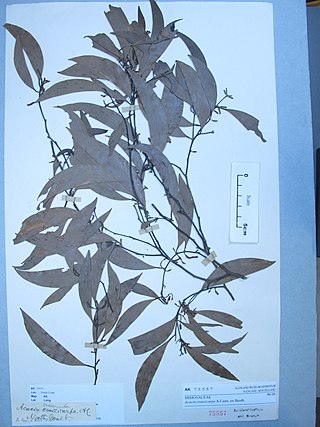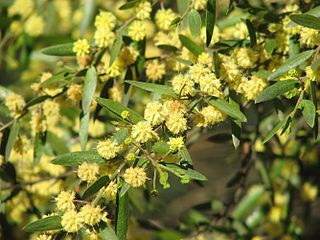
Acacia s.l., known commonly as mimosa, acacia, thorntree or wattle, is a polyphyletic genus of shrubs and trees belonging to the subfamily Mimosoideae of the family Fabaceae. It was described by the Swedish botanist Carl Linnaeus in 1773 based on the African species Acacia nilotica. Many non-Australian species tend to be thorny, whereas the majority of Australian acacias are not. All species are pod-bearing, with sap and leaves often bearing large amounts of tannins and condensed tannins that historically found use as pharmaceuticals and preservatives.

Erringibba is a national park at Glenmorgan in the far west of the Darling Downs region of southern Queensland, Australia, 329 km west of Brisbane. The park was established in 1999 and covers 8.77 km2 (3.39 sq mi). The park lies within the catchment area of the Condamine River and the Brigalow Belt South bioregion.

Sclerophyll is a type of vegetation that has hard leaves, short internodes and leaf orientation parallel or oblique to direct sunlight. The word comes from the Greek sklēros (hard) and phyllon (leaf).

Acacia aneura, commonly known as mulga or true mulga, is a shrub or small tree native to arid outback areas of Australia. It is the dominant tree in the habitat that it gives its name to (mulga) that occurs across much of inland Australia. Specific regions have been designated the Western Australian mulga shrublands in Western Australia and Mulga Lands in Queensland.

Acacia Ridge is a southern suburb in the City of Brisbane, Queensland, Australia. In the 2016 census, Acacia Ridge had a population of 7,429 people.

Acacia pycnantha, most commonly known as the golden wattle, is a tree of the family Fabaceae native to southeastern Australia. It grows to a height of 8 m (26 ft) and has phyllodes instead of true leaves. Sickle-shaped, these are between 9 and 15 cm long, and 1–3.5 cm wide. The profuse fragrant, golden flowers appear in late winter and spring, followed by long seed pods. Plants are cross-pollinated by several species of honeyeater and thornbill, which visit nectaries on the phyllodes and brush against flowers, transferring pollen between them. An understorey plant in eucalyptus forest, it is found from southern New South Wales and the Australian Capital Territory, through Victoria and into southeastern South Australia.

Vachellia farnesiana, also known as Acacia farnesiana, and previously Mimosa farnesiana, commonly known as sweet acacia, huisache, or needle bush, is a species of shrub or small tree in the legume family, Fabaceae. It is deciduous over part of its range, but evergreen in most locales. The species grows to a height of 15–30 feet (4.6–9.1 m) and grows multiple trunks. The base of each leaf is accompanied by a pair of thorns on the branch. Its flowers are used in the perfume industry.
George Don was a Scottish botanist and plant collector.

Acacia, commonly known as the wattles or acacias, is a large genus of shrubs and trees in the subfamily Mimosoideae of the pea family Fabaceae. Initially, it comprised a group of plant species native to Africa and Australasia, but it has now been limited to contain only the Australasian species. The genus name is New Latin, borrowed from the Greek ἀκακία (akakia), a term used by Dioscorides for a preparation extracted from the leaves and fruit pods of Vachellia nilotica, the original type of the genus. In his Pinax (1623), Gaspard Bauhin mentioned the Greek ἀκακία from Dioscorides as the origin of the Latin name.

Acacia mearnsii, commonly known as black wattle, late black wattle or green wattle, is a species of flowering plant in the family Fabaceae and is endemic to south-eastern Australia. It is usually an erect tree with smooth bark, bipinnate leaves and spherical heads of pale yellow or cream-coloured flowers followed by black to reddish brown pods. In some other parts of the world, it is regarded as an invasive species.

Acacia terminalis is a shrub or small tree to 6 m in height. It's an Australian native whose range extends through New South Wales, Victoria and Tasmania.
Leslie Pedley was an Australian botanist who specialised in the genus Acacia. He is notable for bringing into use the generic name Racosperma, creating a split in the genus with some 900 Australian species requiring to be renamed, since the type species of Acacia, Acacia nilotica, now Vachellia nilotica, had a different lineage from the Australian wattles. However, the International Botanical Congress (IBC) in Melbourne in 2011 ratified their earlier decision to retain the name Acacia for the Australian species and to rename the African species.

Acacia crassicarpa is a tree native to Australia (Queensland), West Papua (Indonesia) and Papua New Guinea.
Acacia aneura var. intermedia is a perennial shrub or tree native to Australia.
Acacia coriacea subsp. sericophylla is a shrub or tree growing 2 m to 10 m high. This subspecies of Acacia coriacea, sometimes considered a full species, is endemic to northern Australia. It flowers all year. Its flowers are light yellow to cream-colored.

Grevillea obtecta is a spreading shrub which is endemic to Victoria, Australia. It is known by the common names Fryerstown grevillea, Elphinstone grevillea, or Taradale grevillea. It grows to 0.5 metres in height and about 1.2 m in width The flowers, which are light green to yellow, appear between August and November in its native range.

Acacia didyma is a shrub or small tree which is native to Western Australia. It grows to between 1.5 metres and 4 metres in height and flowers from August to October in its native range.

Acacia verniciflua, commonly known as varnish wattle, is a shrub or small tree species that is endemic to Australia. It has an erect or spreading habit, growing to between 1 and 6 metres high, The phyllodes are often sticky and lustrous and vary in length, width and shape. The globular pale-yellow flowerheads appear in the leaf axils from July to November, followed by seedpods that are up to 10 cm long and unconstricted. These contain shiny black seeds. It is often found growing alongside Eucalyptus obliqua where it can dominate the understory.

Acacia mucronata, the variable sallow wattle or narrow-leaved wattle, is a shrub or small tree to 5 m high. It is native to southeast Australia, mainly the states of Tasmania and Victoria. It often grows as an understorey tree or shrub in eucalypt forest or as a dominant in scrubland. In drier regions of its distribution, like in northeast Tasmania, it often grows along creeks and sheltered coastlines.

Acacia hakeoides, known colloquially as hakea wattle, is a species of Acacia native to southern Australia.















